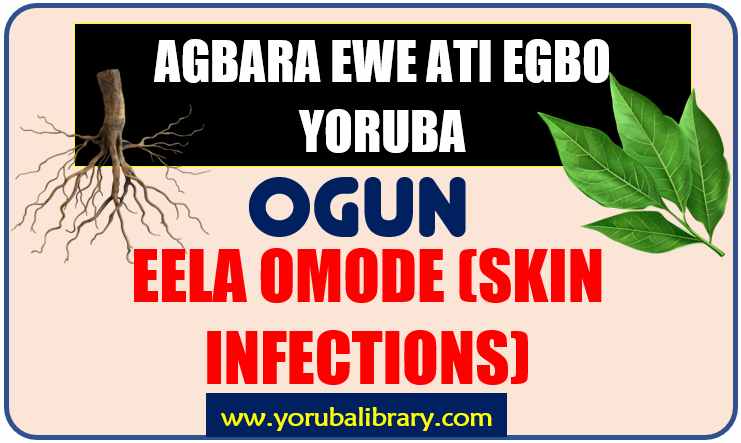
support@yorubalibrary.com
+2348073529208, 07038599574

Among the Yoruba, the health of a child is considered a reflection of both the family’s wellbeing. Skin conditions like impetigo, known locally as Eela, are taken seriously, as they can cause discomfort, infection, and lasting marks if untreated. This is why our forefathers developed Agbo Eela, a traditional healing system designed to treat impetigo in babies safely, soothe irritation, and prevent recurrence. Agbo Eela is more than a mixture of leaves and roots; it is an approach that strengthens the child’s skin, supports the immune system, and incorporates cleansing to remove influences that may weaken the child’s vitality.
Agbo Eela is more than a mixture of leaves and roots; it is an approach that strengthens the child’s skin, supports the immune system, and incorporates cleansing to remove influences that may weaken the child’s vitality.
For countless years, this practice has helped infants recover from skin infections long before hospitals or modern medicine were widely accessible. Even today, many families rely on these remedies as part of the natural option for their children.
Disclaimer
Yoruba Library and its Team will not be held liable for improper usage or any loss arising from improper use, wrong application, inability to find needed materials, or misinterpretation of this article. This article is provided strictly for guidance and educational purposes.
Symptoms of Infant Skin Infections
In Yoruba tradition, elders and mothers paid close attention to signs that a child may be suffering from impetigo or similar skin infections. These observations helped them know when to prepare Agbo Eela remedies:
1) Red, itchy sores – Patches that appear around the face, hands, or diaper area.
2) Pus-filled lesions – Yellowish crusts forming on affected areas.
3) Spread of rash – Rapid expansion of sores across the skin.
4) Irritability and sleeplessness – Discomfort causes the baby to cry excessively or sleep poorly.
5) Excessive scratching or discomfort – Constant irritation indicating the child’s inability to cope with the affliction.
How Our Forefathers Treated Eela in the Past
When babies showed symptoms of impetigo, Yoruba elders used carefully structured remedies and rituals:
• Herbal decoctions — Leaves and roots boiled into gentle tonics to cleanse the skin and strengthen immunity.
• Bathing with selected leaves — Warm herbal baths to soothe inflammation and disinfect sores.
• Topical application — Crushed leaves or pastes applied directly to lesions for faster healing.
Included below are some of the plants and roots needed to prepare Agbo Eela:
a) Ewe Iyalode
b) Ewe Efinrin
c) Ewe Ewure
d) Egbo Ogege
e) Egbo Igi Peregun
f) Eso Orombo
Have you heard of Yoruba Herb Dictionary? This contains names of Yoruba Leaf, Roots, Barks, Characteristics, Properties & Identification with HD Pictures. Order below or download sample here
A-Z HERBS & LEAF DICTIONARY #4KOne Yoruba proverb says "Bí olóde ò kú, òde rè kì í wu Gbégi". Do you know that Gbégi is actually a leaf/plant? Get Yoruba Proverbs on Plants and Herbs, which is a collection of Untold Wisdoms Hidden in Leaf and plants comprising their Life Applications & Moral Teachings. Order below or download sample here
YORUBA PROVERBS ON PLANTS #4KThe Healing Process in Traditional Practice
When preparing Agbo Eela, Yoruba elders followed structured steps to ensure poetency:
1. Collecting herbs, leaves, and barks — Done at specific times to enhance potency.
2. Purifying and preparing the materials — Crushed, boiled, or pounded into gentle pastes or baths suitable for infants.
3. Testing the first application — Small doses applied to monitor reaction before full use.
4. Combining treatment with dietary and care practices — Ensuring proper hygiene and supportive feeding.
Differences Between Yoruba and Modern Skin Infection Treatment
While both Yoruba and modern systems aim to treat skin infections, their approaches differ:
• Focus of healing —
Yoruba remedies emphasize utmost care of the skin and immunity; modern medicine focuses on antibiotics or topical creams.
• Materials used —
Yoruba healers rely on herbs, leaves, and natural pastes; modern treatment uses pharmaceutical ointments or medications.
• Approach to recurrence —
Yoruba healing includes spiritual cleansing and preventive care; modern medicine often relies on repeated prescriptions.
Safety First: Important Contraindications and Considerations
1) Age sensitivity — Remedies must be suitable for infants; strong herbs may harm delicate skin.
2) Underlying conditions — Babies with allergies or chronic illnesses require cautious use.
3) Quality of source — Herbs from polluted or chemically treated areas are unsafe.
Needed Materials (Leaves, Roots, Bark, etc.)
The medicinal approach for this requires careful selection of natural materials traditionally known to our elders. These are combined to ensure potency.
The instruction you will receive is the original account of our forefathers, preserved and tested over time. Many people have used them with testimonies of relief. Just ensure you follow the correct guidelines. Click Unlock Secret below
Application Process
The strength of Yoruba medicine depends on how materials are handled. Proper pounding, boiling, or steeping — done in the right way and at the right time — ensures the remedy remains potent. Click Unlock Secret below
Uses
The prepared remedy must be applied in the correct manner — whether for drinking, steaming, bathing, or chest rubbing — and taken in the right dosage for it to remain effective.
1) Some leaf required special utterances/chants before they can be effective. Where applicable, this will be stated in the PDF
2) The methods of getting the needed items like leaf, bark, roots by yourself is covered in the PDF
3) Saa bi Ologun ti wi, ki o le baa je... (Follow instructions for it to remain potent). You're getting a Real and Original account of our fore fathers.
With Numerous Satisfied Clients...